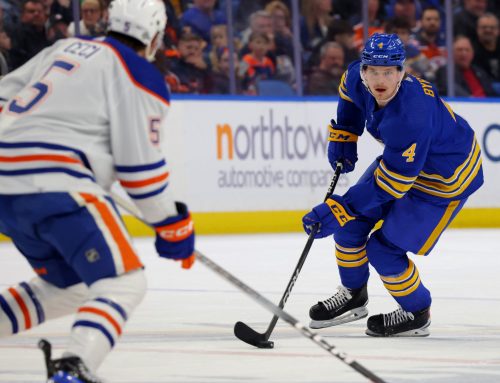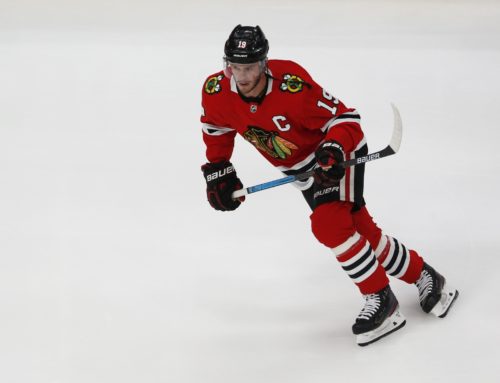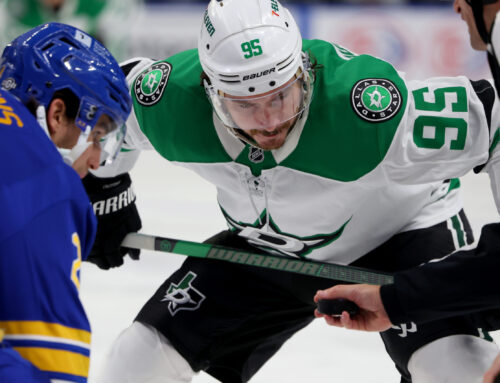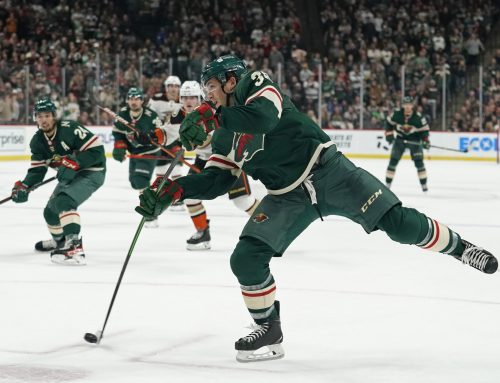
Be sure to head to the Dobber Shop to get your copy of the 2019-20 Dobber Hockey Fantasy Guide! It has everything that fantasy owners need from projections and rankings, to depth charts and prospects, over- and under-valued players, and a whole lot more. And it’s updated all throughout training camp! Get to our store and grab your copy now.
*
I wanted to share a very exciting piece of research done recently by Alex Novet over at Hockey Graphs.
Hockey analytics started out by counting shot attempts. It feels weird to say that it took the general hockey world about 100 years to figure out that generating more shots than your opponent is a good thing, but innovation in sports has lagged behind almost across the board. Anyway, that was a big breakthrough, and about 10 years after that we got our first expected goals model. These models are effectively another counting model, but they count the probability of each shot actually going in based on historical scoring rates on similar shots from similar locations rather than just the shot itself. It was another improvement in analytics and a big step forward.
Now, that piece from Novet starts to cover one weakness of expected goals models and that’s pre-shot movement. For example, expected goals models count a wrist shot from the right faceoff dot as all effectively the same, even though some are just wasted shots while some are cross-ice one-timers that can have an open net. Both shots don’t have the same probability of going in but are treated the same in expected goals models. That’s where Novet’s research comes in.
He takes the data from Corey Sznajder’s data set – he does much of the public game-tracking on things like pass locations, zone entries/exits, and a lot more – and creates a model that tries to incorporate basic pre-shot movement based on pass totals and pass locations. Now, as Mr. Novet points out, the data set is far from complete, but it’s a start in the right direction in preparation for whenever the NHL actually rolls out the player tracking technology and we can be more precise with these things. It’s an exciting time for hockey stat heads.
*
Let’s talk about goalies for a second.
Realistically, I don’t like talking about goalies very much. The reasons for this are as follows:
- It is a very random position. It is a very important position in fantasy (one of the most important in all fantasy sports, really), but it’s still random.
- It takes a long time (several seasons) to know how good a goalie is, and even after several seasons to evaluate, there’s still a margin for error big enough to make a very good fantasy goalie below-average.
- The discourse around goaltending can sometimes seem to overlook the first two points; “So-and-so was great in the last half last year,” or “so-and-so broke out last year so that’s his new talent level,” or some variant of those two statements, are exceedingly common. We can have three 55-start seasons from a goaltender and still not have an accurate picture of how good they really are, and every goaltender is capable of Vezina-calibre seasons (see: Islanders, New York). Just because they’ve been good for a year or two does not mean they will continue to be good, and just because they’ve finally had a good season does not mean we can anticipate more good seasons (we’ll get to one of those guys later). It’s just the nature of the position.
I just find most conversations exhausting because a lot of people seem to be very over-confident about their goaltending evaluation skills and it just ends up a pointless argument. It’s okay to say, “I don’t know,” or “I’m not sure,” y’all. And I say that as someone who knows next to nothing about the position.
Anyway, despite my hesitation to discuss goalies, I wanted to just go over a few I’m at least keying in on for now. Things can change over the next 6-7 weeks, but these are at least guys I’m going to have on my watch list for now.
I happened to catch a back-and-forth Dobber had on Twitter a few weeks ago about Schneider. I think a very salient point that he made was this:
Yes, it's a big risk.
Luongo had same surgery, says it takes 18 months to heal. It took Schneider that long.— Dobber (@DobberHockey) July 29, 2019
If I’m not mistaken, Schneider’s last hip surgery came after the season in 2018. Doing the mental math – which I’m very bad at – then 18 months would put him somewhere around October-November for a recovery timeline that Dobber mentioned from Luongo.
Let’s go over the two reasons to draft Schneider.
First, it’ll be the cost. Despite the hubbub around the Devils, it’ll likely be the youngster MacKenzie Blackwood who is drafted somewhere among the top-20 to top-25 goalies, and not Schneider. I wouldn’t be surprised, given his .907 save percentage over the last three years, to see Schneider outside the top-30 goalies and among the backups. If that is indeed the case, he can be drafted as a third, maybe fourth goalie, depending on the size of the league. If Blackwood is nails out of the gate and Schneider is stapled to the bench, it’s easy to head to the waiver wire and replace him with another backup, or just stream. If Blackwood flounders, then we got a starting goalie basically for free at the draft table.
Second, as alluded to with the hubbub, the Devils should be much improved from last year. Up until the Taylor Hall injury at Christmas, the Devils were near the middle of the league in expected goals against per 60 minutes at five-on-five. That’s not great, obviously, but that roster has since added Nikita Gusev, Jack Hughes, and P.K. Subban. Throw in a healthy Hall, a pinch of Kyle Palmieri, and a dash of underrated-yet-good-and-still-improving Nico Hischier, and this roster is starting to round out. Maybe the team is about the same defensively they were before the Hall injury but there’s going to be a boost offensively, making wins a bit easier to come by.
I understand the hesitation to draft him given the injury history and the split-start possibility. But those are only real concerns if we were drafting him as a number-1 or number-2 goalie. As a number-3 or number-4, we can get away with a failure if that’s his fate.
Last year, when Buffalo signed Carter Hutton, I wrote the following:
“For my money, I would rather take [Linus] Ullmark as a fourth goalie in 12-team leagues than Hutton as a 2nd or early 3rd. There may be a split start in favour of Hutton, but it’s probably closer to 50 than 60 (editor’s note: he made 48 starts). Given the quality of the team, it seems smarter to take a flier on the backup than spend significant draft capital in the starter.”
Hutton was often drafted just inside the top-20 goaltenders and posted a .908 save percentage, 3.00 goals against average, and 18 wins. Ullmark, meanwhile, was often drafted around the top-50 goalies and posted a .905 save percentage, 3.11 goals against average, and 15 wins. Now, we lucked out with the wins because of goal support, but would you rather have drafted Hutton and those ratios as your second goalie, or Ullmark and his numbers as your fourth?
Hutton turns 34 years old in December. He has two seasons with a save percentage of at least .915 (and one of those seasons was with 15 starts), one season with a save percentage of at least .920 (which he parlayed into a three-year deal, very shrewd), and has one (1) season where he has appeared in at least half his team’s games. Did I mention he’ll be 34?
This isn’t to say I think Ullmark is great, or even better than Hutton, I honestly don’t know. It’s that Buffalo will be an improved team and Ullmark will be ull-tra cheap at the draft table (wocka wocka). I don’t think Hutton is very good and it won’t take much more than a few good starts for Ullmark to grab the starter reigns, at least for the short term.
Gibson probably deserved Vezina consideration last year and the only reason he didn’t was how bad Anaheim is. Consider that among the 175 goalies with 2500 minutes played in a single given season since 2007, Gibson’s 2018-19 season is 12th in goals saved above average (GSAA) – a metric to determine how many goals a netminder saved his team based on shot volume faced relative to the league average – and 7th since the 2013 lockout. The guy with the 7th-best single-season by GSAA over the last six years finished 10th in Vezina voting. El oh el.
For a visual on how bad it was, from Hockey Viz, here’s Anaheim’s shots allowed at 5v5 in 2018-19. Red areas are where they allowed shots at an above average rate compared to the league average. The darker the red, the more the shots allowed:

It’s a bloodbath, so why draft him this year, knowing that if the Ducks are that bad again, even a Vezina-calibre season would barely make him a top-25 goalie?
Easy: Randy Carlyle, or the lack thereof.
Carlyle was fired by the Ducks last year on February 10th. Up until that point, the Ducks had allowed the second-most shot attempts per 60 minutes at 5v5, and the second-most expected goals against. It was pitiful.
After February 10th, though, the team improved to 19th in shot attempts allowed and 21st in expected goals against. Obviously still not great, but there’s a pretty big gap between being 20th and being 30th in the league. About a third of the league in difference, in fact.
And the coaching change wasn’t even with a new coach. It was the GM! Bob Murray was their coach and took a bad and injured team to respectability. What is Dallas Eakins going to do with a healthy roster, more young players that he knows, and a full summer and training camp? Hopefully better than Murray!
Again, I get the hesitation here. Anaheim was really bad last year and is in the midst of turning over the team to their youngsters. I genuinely do not think they’ll be anywhere near as bad as they were under Carlyle, though, and if Gibson is going anywhere outside the top-15 goalies (and I presume he will), he’ll be a favourite target of mine because even though I loathe goaltender evaluations, I do think Gibson is one of the best goalies in the league.





 CHI
CHI SEA
SEA FLA
FLA DAL
DAL WPG
WPG CBJ
CBJ L.A
L.A S.J
S.J N.J
N.J COL
COL
